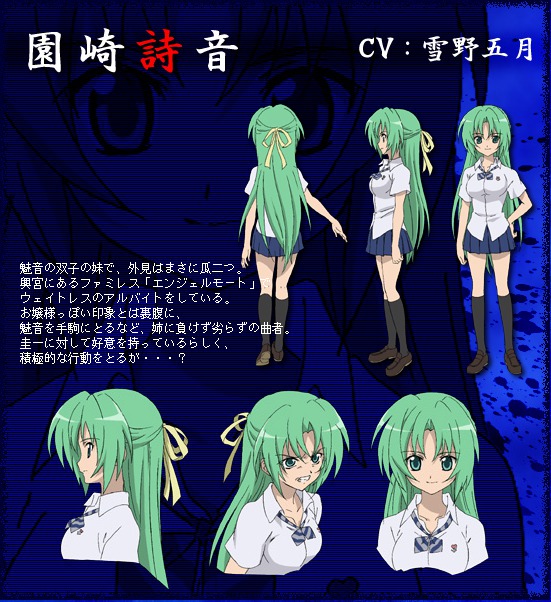
Satoko referred to Satoshi as " Nii-Nii" (にーにー) from 兄 ( ani・older brother), a cute term for older brother, when he was around, and has since referred Keiichi as such, as well as calling Sonozaki Shion the female equivalent, " Nee-Nee" (ねーねー) from 姉 ( ane・older sister), though in previous arcs, Shion, pretending to be Mion, had murdered Satoko. Like Ryūgū Rena, Satoko can be incredibly analytical and intuitive at times in Tsumi horoboshi-hen when Rena held the school hostage, Satoko was able to completely map out the blueprint of the school and the location of the bomb in her head, as well as connect all of the various clues together, especially pieces of seemingly-useless information such as what types of containers were used to hold the gasoline Rena used, the reason a students' ball went missing, how the drain canal runs, and how and where the bomb was set up. Her traps can be dangerous, however in Matsuri bayashi-hen, she set traps for the Yamainu, some of which proved fatal.
HIGURASHI SHION ANGRY SERIES
She has a very distinctive laugh, 'vampire fangs' as Keiichi describes, and loves to set traps to play pranks on her friends, though in the series these seem to always target Maebara Keiichi.

Satoko, despite her past, is an energetic and playful girl. Satoshi then disappeared, Teppei fled to Okinomiya to live with his mistress and Satoko started living with her recently orphaned friend Furude Rika. When the Watanagashi Festival came around, Tamae was murdered by Satoshi to protect his sister from the abuse. Satoko was abused during that time and always clung to her brother. She was saved thanks to Irie's development of C-103. Afterwards, she and Satoshi were taken in by their uncle and aunt, Hōjō Teppei and Tamae, respectively. Satoko was later hospitalized at the Irie Clinic to be treated for her poor health, and was almost vivisected as a terminal subject in research of Hinamizawa Syndrome. Satoko was happy and rushed to hug her parents, but the corroded railing gave in, and Satoko's parents fell to their deaths, right before her eyes. Satoko did have suspicions about her parents, but she overheard them at Shirakawa Park, talking about how much they love Satoko, and want to make up with her.

In the console-only alternate ending arc Mio< tsukushi-hen, a different backstory is presented. In what she considered as self-defense, she pushed them over the cliff. When they took her to a viewing platform over a muddy river, she was certain that they were going to kill her right there. However, the parents' attempt to get closer to Satoko only worsened her suspicions and paranoia. This belief was the starting point of her entering the L5 terminal phase of the Hinamizawa Syndrome.Īccording to Irie's theory in Matsuri bayashi-hen, on the day of the Watanagashi Festival on June 1980, Satoko's parents decided to take her out to Shirakawa Park to escape from the celebration of the villagers' victory over the dam project, and to support Mr. Since Satoko was somewhat of a nuisance towards her parents, she believed that they would be better off without her, and would kill her at some point.

He and Satoko's mother were supporters of the Dam Project in Hinamizawa which caused them to be shunned by other villagers who branded them "traitors." Due to the stance of their parents, the villagers distrusted Satoko and her older brother as well. Each step-father responded severely to her tricks, but whenever she recounted the abuse, she believed that her current Hōjō step-father did all of it.

The only family member that she felt she truly trusted was her older brother, Satoshi.Īt some point, she started playing pranks on her step-fathers. This included a fake abuse report against Mr. Men kept appearing beside her mother one after another, and Satoko could not adjust to any of them. In fact, she could never decide whether or not she actually liked her mother, since their relationship was far from perfect. Satoko never understood why her and Satoshi's mother repeatedly married and divorced various men. 3 Higurashi no Naku Koro ni Rei (ひぐらしの なく頃に令).


 0 kommentar(er)
0 kommentar(er)
